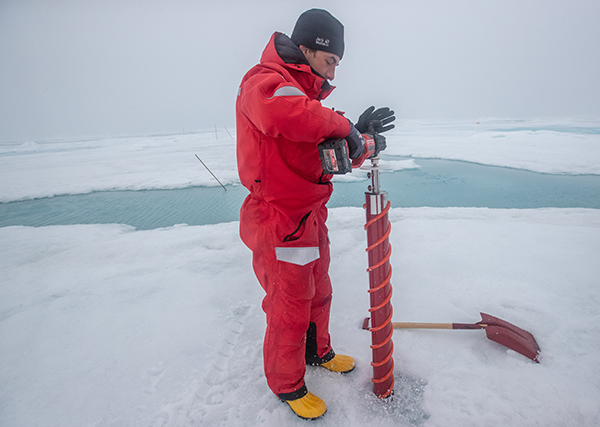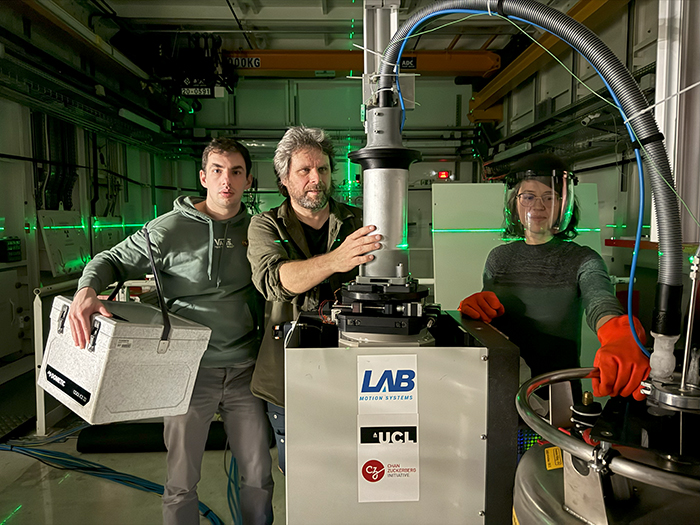- Home
- News
- General News
- #EBSstory From the...
#EBSstory From the Arctic to the ESRF: studying ice from the epicenter of global warming
01-02-2024
A team of scientists from the MOSAiC expedition have come to the ESRF to study Arctic sea ice to understand the changes it undergoes due to global warming.
Global warming is affecting the Arctic about three times faster than the rest of the world. This so called “Arctic Amplification” is strongly related to a changing sea ice cover, less sea ice area reflecting less solar radiation back to space, thereby warming the Arctic. The Arctic sea ice in turn is undergoing significant transformations associated with this climate change. Today, the ice is thinner and younger compared to the traditional several years old, thick pack ice from the 20th century. It melts and grows faster and is more susceptible to drift and deformation driven by winds and ocean currents.
Much of our understanding, how sea ice behaves and couples the processes in the atmosphere and the ocean, is based on model development and observations from the last century, when Arctic sea ice reached 3-4-metre thickness. With the thinner ice today (roughly half in thickness), models have to be revised. This is challenging, as also the conditions in the atmosphere (warming) and the ocean have changed. For example, while the Gulfstream has decreased over the past 40 years, and the North Atlantic Ocean has cooled, the inflow to the Arctic has become warmer, potentially melting more sea ice.
 |
|
Evgenii Salganik at work in the Arctic. Credits: Lianna Nixon. |
Due to the complex atmosphere-ice-ocean interactions, the future of Arctic sea ice under changing climate is still uncertain. An ice-free Arctic would impact global climate and society in many ways, like extreme weather and a struggle about exploration and shipping rights in the vulnerable North. On the other extreme side, even the scenario of the shutdown of the Gulfstream system (or Atlantic Meridional Overturning Circulation, AMOC) with sea ice extension and catastrophic cooling in Europe, while currently more unlikely, cannot be dismissed. The role of sea ice during these scenarios is not clear, as we are lacking a full understanding of sea ice microstructure and properties.
Sea ice differs very much from freshwater ice. It is a porous medium consisting of an ice matrix in which liquid brine and air are embedded as networks and inclusions. Thinner and warmer sea ice tends to contain more liquid brine – it is more porous. This changes the physical properties of the ice, yet it also affects its role in the Arctic ecosystem, where important biogeochemical processes are related to freezing, melting and fluid flow in the sea ice pore space.
To get the real picture about the processes that sea ice and the Arctic are going through, the largest polar expedition in history, MOSAiC (Multidisciplinary drifting Observatory for the Study of Arctic Climate), took place in 2019-2020 on the icebreaker Polarstern, which spent a year drifting through the Arctic Ocean with hundreds of scientists involved. One of the major focuses of MOSAiC was to gain a better understanding of the evolving Arctic system through simultaneous year-long observations in the atmosphere, sea ice and the ocean.
Arctic ice at BM18
Fast-forward four years and today, six of those scientists are at the ESRF, juggling temperature probes and portable freezers with different temperatures as they place the precious sample, a chunk of ice core of Arctic ice of 20 cm length and 9 cm of diameter, on the experimental hutch of the new BM18 beamline. The goal: to decipher the microstructure of ice using X-ray microtomography. The team is made up of researchers from the Norwegian University of Science and Technology and the Norwegian Polar Institute , the WSL Institute for Snow and Avalanche Research SLF and ETH Zurich in Switzerland the University of Liège in Belgium.
 |
|
Evgenii Salganik, Sönke Maus and Alice Pradel (from left to right) setting up the sample on BM18. Credits: A. Daurat. |
“There are many uncertainties in properties of sea ice today, and our samples allow us to get a full picture of the microstructure of ice throughout the whole year in the Arctic. This information will be important for many sea ice properties and processes that depend on its microstructure, from physics and engineering, to ecology and biogeochemistry as well as remote sensing”, says Sönke Maus, researcher from the Norwegian University of Science and Technology and leader of the team. He adds: “For example, the bubbles and pores scatter light and determine how sea ice reflects solar radiation; they act as flaws and ease the fracture of ice; they act as habitats for life and may store nutrients, but also pollutants”.
The group transported the ice samples themselves by car from northern Germany to Grenoble, using a self-assembled cooling system. “Our goal is to keep the temperature of the scanned ice as close as possible to its temperature when it was sampled in the central Arctic, as temperature changes would affect the porosity”, says Evgenii Salganik, post-doctoral researcher at the Norwegian Polar Institute. He adds that “the characterisation of gas and brine porosity will also support ice thickness estimates from sea ice remote sensing”.
Behind the scenes, Benoit Cordonnier, scientist on BM18, and the Sample Environment group makes sure that everything is perfectly set up for the success of the research. “The experiment is challenging because we had to create a specific set-up to make sure the temperature stays constant during the scans”, he says.
So far, the team is happy of how the first scans are going. “Thanks to the capabilities of the new BM18 beamline, we can now study big samples of ice, which is what we need to get a representative view of the different ice structures”, adds Maus.
For Salganik, being at the ESRF is a very different experience than being onboard of the Polarstern: “This is the follow-up of the field work we did up in the Arctic, and it is very gratifying to see that the ESRF can provide us with answers to our questions”, he concludes. “We hope that our study will contribute to better ice models in the future”.
https://mosaic-expedition.org/
Text by Montserrat Capellas Espuny
Top image: The Polarstern during the expedition. Credits: E. Salganik.



